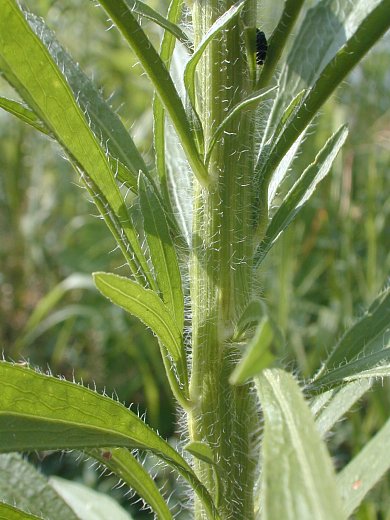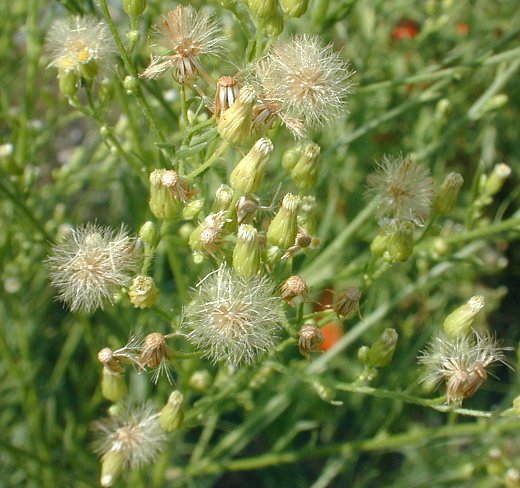Description: This plant is a summer annual that ranges in size from ½' to 7' tall; it is unbranched, except for the flowering stems toward its apex. The stout central stem is light green and angular-terete; it is covered with spreading white hairs. Alternate leaves occur along the entire length of this stem, where they are densely arranged and appear to be almost whorled. These leaves become only slightly smaller in size as they ascend; they are typically 2–3½" and ¼–½" across, although the leaves of very short plants and the uppermost leaves of other plants can be smaller than this. The leaf blades are usually ascending, rather than widely spreading; they are elliptic, narrowly lanceolate, or narrowly oblanceolate in shape. The lower leaf blades have relatively few dentate teeth along their outer margins, otherwise they are toothless. The middle to upper leaf blades have toothless margins; the margins of all leaves are conspicuously ciliate. The leaves are sessile or nearly so, while their tips are tapered and acute. The upper leaf surface is medium green and either glabrous or sparsely hairy along the outer length of the central vein; the lower leaf surface is light-medium green and either glabrous or sparsely hairy along the entire or outer length of the central vein.

At maturity, the central stem terminates in a panicle of flowerheads up to 1½' long and ½' across. In addition, smaller panicles of flowerheads may develop from axillary stems of the upper leaves. Along the branches and branchlets of these panicles, there are leafy bracts up to 1" long and 3 mm. (1/8") across. The branches and branchlets of panicles are light green and either short-pubescent or hairy. Individual flowerheads are about 2-3 mm. across and 4-5 mm. long; they are cylindrical to slightly urn-shaped. Each flowerhead has 25-45 pistillate ray florets that surround 12-25 perfect disk florets. The petaloid rays of the flowerheads are less than 1 mm. long, white, and linear in shape; they are ascending and inconspicuous. The corollas of the disk florets are pale yellow, short-tubular in shape, and 4-lobed. The base of each flowerhead is surrounded by tiny phyllaries (floral bracts) in 3-4 overlapping series. These phyllaries are predominately light green, linear in shape, hairless or nearly so, and appressed together. The peduncles of the flowerheads are up to 6 mm. (¼") long. The blooming period can occur from mid-summer into autumn, lasting about 2-3 weeks for individual plants. There is either no noticeable floral scent or it is mild and sweet. In the absence of insect pollination, the florets are self-fertile. Afterwards, the florets are replaced by achenes with small tufts of white to grayish white hair. The achenes are 1–1.5 mm. long, light yellowish gray, and narrowly cylindrical-ellipsoid in shape. The achenes are distributed by the wind. The root system consists of a short taproot with secondary fibrous roots.

Cultivation:
The preference is full sun, mesic to dry conditions,
and fertile loamy
soil. However, this plant also adapts to other kinds of soil, including
those that contain considerable amounts of clay or gravel. This weedy
plant usually develops rapidly during the summer, although the ultimate
size of individual plants is highly variable, depending on moisture
conditions and fertility of the soil. It has good resistance to summer
drought, although some of the lower leaves may turn yellow and wither
away. In sunny locations with exposed topsoil, this plant can reseed
itself aggressively.
Range & Habitat:
Horseweed is a very common plant that occurs in every county of
Illinois (see Distribution
Map),
where it is native. In natural areas, habitats include disturbed areas
of upland prairies and weedy meadows. In more developed areas, habitats
include abandoned fields, pastures, fence rows, vacant lots, garbage
dumps, gravelly lots, construction sites, areas along railroads, poorly
maintained roadsides, gardens with exposed topsoil, and miscellaneous
waste areas. Disturbed areas are highly preferred. This plant has
become an invasive weed in Eurasia.

Faunal Associations: The flowerheads of Horseweed (Conyza canadensis) attract small Halictid bees, Sphecid wasps, Vespid wasps, Perilampid wasps, Syrphid flies, Tachinid flies, flesh flies (Sarcophaga spp.), Muscid flies, plant bugs (Miridae), and other insects. Bee visitors suck nectar or collect pollen, fly visitors suck nectar or feed on pollen, while the remaining floral visitors feed on nectar (Graenicher, 1909; Robertson, 1929). A variety of insects feed on the leaves, bore through the stems, or consume other parts of Horseweed. These species include the stem-boring larvae of a tumbling flower beetle (Mordellistena pustulata), larvae of Calycomyza humeralis (Aster Leafminer) and other leaf-miner flies, larvae of Asteromyia modesta (Horseweed Blister Midge) and Neolasioptera erigerontis (Horseweed Stem Gall Midge), Lygus lineolaris (Tarnished Plant Bug) and Taylorilygus apicalis (Broken-backed Bug), Uroleucon erigeronense and other aphids, Melanoplus differentialis (Differential Grasshopper) and Oecanthus quadripunctatus (Four-spotted Tree Cricket), and the larvae of such moths as Cucullia alfarata (Halloween Paint), Cucullia speyeri (Speyer's Paint), Schinia arcigera (Arcigera Flower Moth), and Schinia lynx (Lynx Flower Moth); see Ford & Jackman (1996), Spencer & Steyskal (1986), Felt (1917), Snodgrass et al. (1984), Hottes & Frison (1931), Blackman & Eastop (2013), Joern (1985), Gangwere (1961), Wagner (2005), and Wagner et al. (2009). Mammalian herbivores usually leave Horseweed alone because the foliage is resinous and bitter (Georgia, 1913). However, deer and rabbits sometimes browse on young plants (Noble Foundation, 2007; personal observation), while to a minor extent muskrats eat the stems of plants that grow near bodies of water (Hamerstrom & Blake, 1939). Horseweed contains a substance (herpene) that can irritate the noses of horses that feed on it. The foliage of this plant can also irritate the skin of some people (Royer & Dickinson, 1999).

Photographic
Location:
The photographs were taken at the webmaster's apartment complex in
Urbana, Illinois.
Comments:
Horseweed (Conyza
canadensis) initially appears to be a tall columnar
goldenrod (Solidago sp.)
that has hairy stems and leaf blades that angle upward from their
bases. However at maturity, it is readily distinguished from a
goldenrod by its rather uninteresting inflorescence with small
flowerheads. If the small flowerheads of Horseweed are examined
closely, their short petaloid rays will become evident and they will
bear some resemblance to the showier flowerheads of fleabane species (Erigeron spp.). At
one time, Horseweed was assigned to the same genus as fleabane species,
and it was referred to as Erigeron
canadensis.
Some uncommon specimens of Horseweed have hairless stems and phyllaries
with either red tips or straw-colored (stramineus) tips. They are
sometimes regarded as distinct varieties of Horseweed.